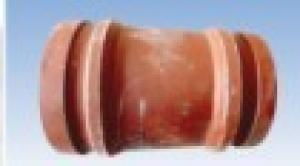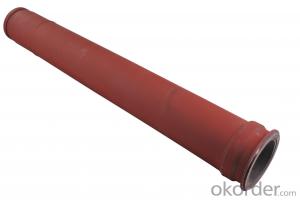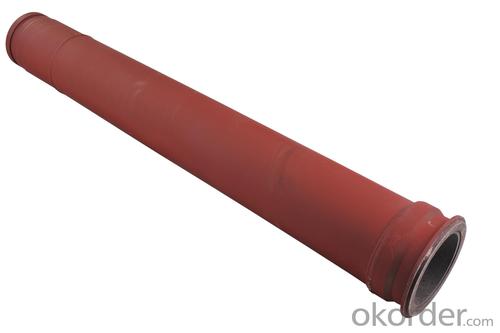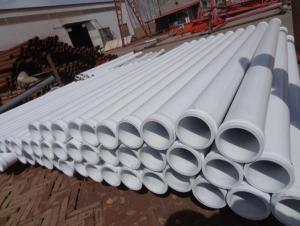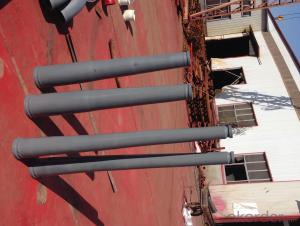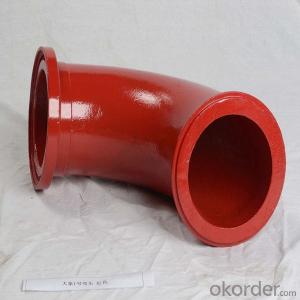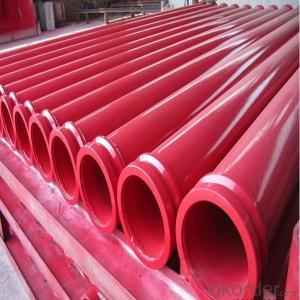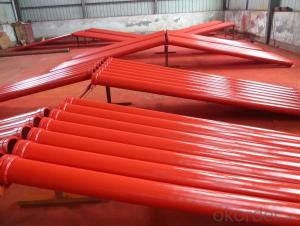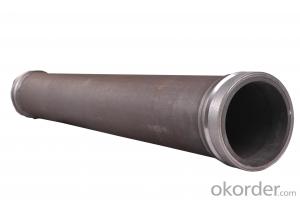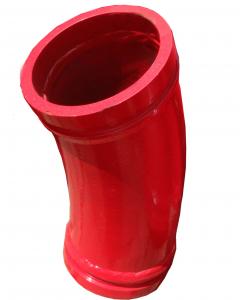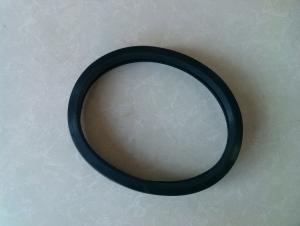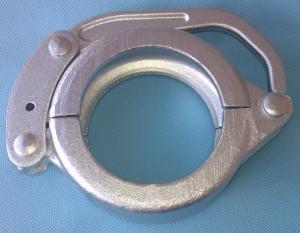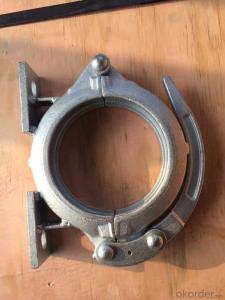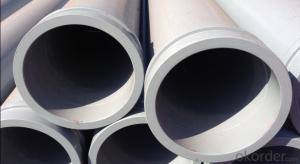Concrete Pump Parts twin wall pipe reducer pipe DN137-DN125 Length 200mm
- Loading Port:
- Tianjin
- Payment Terms:
- TT OR LC
- Min Order Qty:
- 10 pc
- Supply Capability:
- 1000 pc/month
OKorder Service Pledge
OKorder Financial Service
You Might Also Like
twin layer pump reducing pipe
1. ST52/45Mn2/20#
2. HRC: 63
3. Forged weld-on ends
4. Automatic Welding
5. Thickness: inner wall from 7mm to 10mm, inner material is high chrome alloy, outer wall is 3mm seamless steel
6.Service life: above 60,000 cubic meters
other sizes and types accofding to client's requirement
Type | DN | Thickness (mm) | Length (mm) | Weld-on Ends | Weight (kgs) | |
ST52 Steel Pipe | 125 | 4.0 | 3000/ 2000/ 1000 | 148mm | 41 | |
4.5 | 148mm | 46 | ||||
7.0 | 148mm | 72 | ||||
Hardened Pipe | 125 | 4.5 | 148mm Chrome Carbide Insert | 48 | ||
7.0 | 148mm Chrome Carbide Insert | 76 | ||||
Twin-Wall Pipe | 125 | 2+2 | 148mm Chrome Carbide Insert | 45 | ||
2.5+2 | 148mm Chrome Carbide Insert | 48 | ||||
4.5+3 | 148mm Chrome Carbide Insert | 76 | ||||
ZX-Pipe(ST52) | 125 | 7.0 | ZX-5" F/M flanges | |||
Hardened ZX-Pipe | 125 | 7.0 | ZX-5" F/M flanges | |||
Schwing F/M Pipe (ST52 ) | 125 | 4.0 | Schwing 5" F/M flanges | |||
4.5 | Schwing 5" F/M flanges | |||||
7.0 | Schwing 5" F/M flanges | |||||
8.0 | Schwing special F/M flanges | |||||
Steel Pipe | 100 | 4.5 | 3000 | 122mm/127mm/4"HD | ||
4.5 | 2000 | 122mm/127mm/4"HD | ||||
4.5 | 1000 | 122mm/127mm/4"HD | ||||
150 | 8.0 | 6000 | 6"HD/ ZX-6" F/M | |||
8.0 | 3000 | 6"HD/ ZX-6" F/M | ||||
8.0 | 1500 | 6"HD/ ZX-6" F/M | ||||
8.0 | 1000 | 6"HD/ ZX-6" F/M |

- Q: How can one ensure proper functioning of concrete pump spare parts after installation?
- To ensure proper functioning of concrete pump spare parts after installation, it is important to follow a few key steps. Firstly, it is crucial to carefully inspect and clean the parts before installation to ensure they are free from any debris or damage. Additionally, it is essential to use high-quality parts from reputable manufacturers to ensure durability and reliability. Regular maintenance and lubrication of the spare parts is also necessary to prevent wear and tear. Lastly, it is important to operate the concrete pump within its specified limits and avoid overloading, as this can cause stress on the spare parts and lead to malfunctioning.
- Q: What are the different types of concrete pump hopper vibrators?
- On the market, one can find various concrete pump hopper vibrators. Their purpose is to ensure a smooth flow of concrete through the hopper and into the pumping system. 1. Electric Vibrators: The most commonly used hopper vibrators are powered by electricity. They are typically attached to the hopper's side and employ an electric motor to generate vibrations that facilitate the movement of concrete. 2. Pneumatic Vibrators: These vibrators rely on compressed air as their power source and are commonly employed in situations where electricity is not readily accessible. By utilizing air pressure, they create vibrations that aid in the continuous flow of concrete. 3. Hydraulic Vibrators: Larger concrete pumping systems often utilize hydraulic vibrators, which derive their power from hydraulic fluid. These vibrators can be more robust than their electric or pneumatic counterparts, making them suitable for heavy-duty applications. 4. Rotary Vibrators: To move the concrete, these vibrators employ an eccentric weight that spins, resulting in vibrations. They are frequently used when a high frequency of vibration is necessary. 5. Turbine Vibrators: These vibrators employ a turbine mechanism to generate vibrations. They are commonly employed when a low frequency of vibration is desired. 6. Ball Vibrators: These vibrators use a ball housed within a casing to generate vibrations. They are frequently utilized in smaller concrete pumping systems and can be easily mounted onto the hopper. In conclusion, the choice of the most suitable concrete pump hopper vibrator for a specific application depends on various factors, including the size and type of the concrete pumping system, the desired frequency and intensity of vibration, and the availability of power sources.
- Q: Can I get spare parts for both concrete pumps with and without remote control systems?
- Yes, spare parts are available for both concrete pumps with and without remote control systems.
- Q: How can one identify the correct part number for a specific concrete pump spare part?
- To find the appropriate part number for a specific spare part for your concrete pump, there are several steps you can take: 1. Refer to the equipment manual: Start by checking the manual that accompanies your concrete pump. It should contain a comprehensive list of parts, complete with their corresponding part numbers. This is the most reliable and accurate source of information. 2. Get in touch with the manufacturer: If you don't have access to the equipment manual or it doesn't provide the necessary details, reach out to the manufacturer directly. They should be able to help you identify the correct part number for the specific spare part you require. Provide them with as much information as possible, such as the concrete pump's make, model, and serial number. 3. Utilize online resources: There are various online platforms and parts catalogs available that offer detailed information about spare parts for different concrete pump brands and models. These resources often allow you to search for the part based on your concrete pump's make and model. However, make sure to cross-reference the information with the manufacturer's specifications to ensure accuracy. 4. Seek advice from a local dealer or distributor: If you're unable to find the correct part number through the aforementioned methods, consider contacting a local dealer or distributor specializing in concrete pump spare parts. They typically possess extensive knowledge and experience in identifying and sourcing the right parts for various equipment. Provide them with all the necessary details about your concrete pump, and they should be able to assist you in finding the correct part number. Remember, accuracy is crucial when determining the correct part number for a specific concrete pump spare part. Relying on trustworthy sources and consulting professionals will help guarantee that you obtain the appropriate part to meet your equipment's requirements.
- Q: How can a damaged concrete pump hopper affect the pumping process?
- A damaged concrete pump hopper can significantly impact the pumping process as it plays a crucial role in the overall efficiency and functionality of the equipment. Firstly, a damaged hopper can lead to a decrease in the pump's performance by causing blockages or clogs in the system. This can result in disruption or even a complete halt to the pumping process, leading to delays and increased downtime. Secondly, a damaged hopper can also lead to a loss of concrete, as it may leak or spill during the pumping operation. This not only wastes material but can also create safety hazards and environmental concerns. Therefore, it is essential to promptly address any damage to the concrete pump hopper to ensure smooth and efficient pumping operations.
- Q: Are there any environmental considerations in the production of concrete pump spare parts?
- Yes, there are environmental considerations in the production of concrete pump spare parts. Concrete production itself is known to have a significant environmental impact due to the extraction and processing of raw materials, as well as the energy consumption and carbon emissions associated with its production. Therefore, the production of concrete pump spare parts should prioritize eco-friendly manufacturing processes, use recycled materials where possible, and minimize waste generation. Additionally, the selection of suppliers and transportation methods should aim to reduce the carbon footprint of the supply chain.
- Q: How does a concrete pump piston work?
- A concrete pump piston works by creating a reciprocating motion that pushes the concrete through the pump and into the desired location. The piston is a cylindrical component that fits snugly inside a cylinder. It is connected to a rod, which is attached to a hydraulic system. When the hydraulic system is activated, it pushes the rod forward, causing the piston to move in the same direction. As the piston moves forward, it creates a vacuum behind it, drawing the concrete into the cylinder through an inlet valve. Once the piston reaches the end of its forward stroke, the hydraulic system reverses its direction, pulling the rod back and causing the piston to move backward. This closes the inlet valve and opens an outlet valve, allowing the concrete to be forced out of the cylinder and into the delivery line. The reciprocating motion of the piston, along with the alternating opening and closing of the inlet and outlet valves, allows for a continuous flow of concrete through the pump. This process is repeated rapidly, allowing for efficient and consistent pumping of concrete to the desired location.
- Q: How can a faulty battery affect the operation of the pump?
- A faulty battery can significantly affect the operation of a pump. Firstly, a faulty battery may not provide enough power to the pump, resulting in slow or weak pumping action. This can impact the pump's ability to generate the necessary pressure or flow rate, leading to inefficient or ineffective operation. Additionally, a faulty battery may cause intermittent power supply to the pump. This can result in inconsistent pumping action, with the pump starting and stopping sporadically. Such interruptions can create inefficiencies, reduce the pump's performance, and potentially cause damage to the equipment or system being operated. Furthermore, a faulty battery may not hold a charge for an extended period. This can limit the pump's runtime, requiring frequent recharging or replacement of the battery. In scenarios where a pump is needed for continuous or prolonged usage, a faulty battery can disrupt operations, leading to downtime and reduced productivity. Moreover, a faulty battery can also impact the overall lifespan of the pump. If the battery does not provide the necessary power consistently, the pump may experience strain or excessive wear, potentially shortening its operational life. Overall, a faulty battery can have various adverse effects on the operation of a pump, including reduced performance, inconsistent pumping action, limited runtime, potential damage, and decreased equipment lifespan. Regular maintenance and timely replacement of faulty batteries are crucial to ensure optimal pump performance and longevity.
- Q: How does the concrete pump work?
- After position, the pump shall show stop light to avoid collision
- Q: What are the signs of a faulty concrete pump control panel?
- A faulty concrete pump control panel can be identified through various indicators. To begin with, the control panel not powering on or experiencing intermittent power loss may suggest a faulty electrical connection or a malfunctioning power supply. This can hinder the proper functioning of the panel and its ability to control the concrete pump. Furthermore, error messages or error codes displayed on the control panel may indicate issues with the internal components or sensors. These errors can range from minor malfunctions to more serious problems that require immediate attention. Additionally, an erratic behavior or unresponsive controls of the control panel can be observed. If the buttons or switches do not respond when pressed or behave inconsistently, it could signal a problem with the panel's circuitry or wiring. Moreover, the occurrence of unusual noises or vibrations emanating from the control panel may be a sign of internal mechanical issues. These could include loose or damaged components, faulty relays, or malfunctioning motors. Lastly, if the concrete pump does not perform as expected, it may be attributed to a faulty control panel. Insufficient pressure, incorrect flow rates, or difficulties in starting or stopping the pump can all indicate a malfunctioning control panel. Regardless of the indicator, it is crucial to seek the assistance of a professional technician or the manufacturer for inspection, diagnosis, and repair if there is suspicion of a faulty control panel in a concrete pump.
Send your message to us
Concrete Pump Parts twin wall pipe reducer pipe DN137-DN125 Length 200mm
- Loading Port:
- Tianjin
- Payment Terms:
- TT OR LC
- Min Order Qty:
- 10 pc
- Supply Capability:
- 1000 pc/month
OKorder Service Pledge
OKorder Financial Service
Similar products
Hot products
Hot Searches
Related keywords
